Talyllyn Railway
| Talyllyn Railway Rheilffordd Talyllyn | |||||||||||||||||||||||||||||||||||||||||||||||||||||||||||||||||||||||||||||||||||||||||||||||||||||||||||||||||||||||||||||||||||||||||||||||||||||||||||||||||||||||||||||||||||||||||||||||||||||||||||||||||||||||||||||||||||||||||||||||||||||||||||||||
|---|---|---|---|---|---|---|---|---|---|---|---|---|---|---|---|---|---|---|---|---|---|---|---|---|---|---|---|---|---|---|---|---|---|---|---|---|---|---|---|---|---|---|---|---|---|---|---|---|---|---|---|---|---|---|---|---|---|---|---|---|---|---|---|---|---|---|---|---|---|---|---|---|---|---|---|---|---|---|---|---|---|---|---|---|---|---|---|---|---|---|---|---|---|---|---|---|---|---|---|---|---|---|---|---|---|---|---|---|---|---|---|---|---|---|---|---|---|---|---|---|---|---|---|---|---|---|---|---|---|---|---|---|---|---|---|---|---|---|---|---|---|---|---|---|---|---|---|---|---|---|---|---|---|---|---|---|---|---|---|---|---|---|---|---|---|---|---|---|---|---|---|---|---|---|---|---|---|---|---|---|---|---|---|---|---|---|---|---|---|---|---|---|---|---|---|---|---|---|---|---|---|---|---|---|---|---|---|---|---|---|---|---|---|---|---|---|---|---|---|---|---|---|---|---|---|---|---|---|---|---|---|---|---|---|---|---|---|---|---|---|---|---|---|---|---|---|---|---|---|---|---|---|---|---|---|
 Locomotive No. 1Talyllynarrives at Nant Gwernol terminus. | |||||||||||||||||||||||||||||||||||||||||||||||||||||||||||||||||||||||||||||||||||||||||||||||||||||||||||||||||||||||||||||||||||||||||||||||||||||||||||||||||||||||||||||||||||||||||||||||||||||||||||||||||||||||||||||||||||||||||||||||||||||||||||||||
| Locale | Wales | ||||||||||||||||||||||||||||||||||||||||||||||||||||||||||||||||||||||||||||||||||||||||||||||||||||||||||||||||||||||||||||||||||||||||||||||||||||||||||||||||||||||||||||||||||||||||||||||||||||||||||||||||||||||||||||||||||||||||||||||||||||||||||||||
| Terminus | Tywyn Wharf | ||||||||||||||||||||||||||||||||||||||||||||||||||||||||||||||||||||||||||||||||||||||||||||||||||||||||||||||||||||||||||||||||||||||||||||||||||||||||||||||||||||||||||||||||||||||||||||||||||||||||||||||||||||||||||||||||||||||||||||||||||||||||||||||
| Coordinates | 52°35′01″N4°05′19″W/ 52.5837°N 4.0887°W | ||||||||||||||||||||||||||||||||||||||||||||||||||||||||||||||||||||||||||||||||||||||||||||||||||||||||||||||||||||||||||||||||||||||||||||||||||||||||||||||||||||||||||||||||||||||||||||||||||||||||||||||||||||||||||||||||||||||||||||||||||||||||||||||
 Map showing location of Talyllyn Railway | |||||||||||||||||||||||||||||||||||||||||||||||||||||||||||||||||||||||||||||||||||||||||||||||||||||||||||||||||||||||||||||||||||||||||||||||||||||||||||||||||||||||||||||||||||||||||||||||||||||||||||||||||||||||||||||||||||||||||||||||||||||||||||||||
| Commercial operations | |||||||||||||||||||||||||||||||||||||||||||||||||||||||||||||||||||||||||||||||||||||||||||||||||||||||||||||||||||||||||||||||||||||||||||||||||||||||||||||||||||||||||||||||||||||||||||||||||||||||||||||||||||||||||||||||||||||||||||||||||||||||||||||||
| Name | Talyllyn Railway | ||||||||||||||||||||||||||||||||||||||||||||||||||||||||||||||||||||||||||||||||||||||||||||||||||||||||||||||||||||||||||||||||||||||||||||||||||||||||||||||||||||||||||||||||||||||||||||||||||||||||||||||||||||||||||||||||||||||||||||||||||||||||||||||
| Original gauge | 2 ft 3 in(686 mm) | ||||||||||||||||||||||||||||||||||||||||||||||||||||||||||||||||||||||||||||||||||||||||||||||||||||||||||||||||||||||||||||||||||||||||||||||||||||||||||||||||||||||||||||||||||||||||||||||||||||||||||||||||||||||||||||||||||||||||||||||||||||||||||||||
| Preserved operations | |||||||||||||||||||||||||||||||||||||||||||||||||||||||||||||||||||||||||||||||||||||||||||||||||||||||||||||||||||||||||||||||||||||||||||||||||||||||||||||||||||||||||||||||||||||||||||||||||||||||||||||||||||||||||||||||||||||||||||||||||||||||||||||||
| Operated by | Talyllyn Railway Company, supported by Talyllyn Railway Preservation Society | ||||||||||||||||||||||||||||||||||||||||||||||||||||||||||||||||||||||||||||||||||||||||||||||||||||||||||||||||||||||||||||||||||||||||||||||||||||||||||||||||||||||||||||||||||||||||||||||||||||||||||||||||||||||||||||||||||||||||||||||||||||||||||||||
| Stations | 7 and 5 halts | ||||||||||||||||||||||||||||||||||||||||||||||||||||||||||||||||||||||||||||||||||||||||||||||||||||||||||||||||||||||||||||||||||||||||||||||||||||||||||||||||||||||||||||||||||||||||||||||||||||||||||||||||||||||||||||||||||||||||||||||||||||||||||||||
| Length | 7.25 miles (11.67 km) | ||||||||||||||||||||||||||||||||||||||||||||||||||||||||||||||||||||||||||||||||||||||||||||||||||||||||||||||||||||||||||||||||||||||||||||||||||||||||||||||||||||||||||||||||||||||||||||||||||||||||||||||||||||||||||||||||||||||||||||||||||||||||||||||
| Preserved gauge | 2 ft 3 in(686 mm) | ||||||||||||||||||||||||||||||||||||||||||||||||||||||||||||||||||||||||||||||||||||||||||||||||||||||||||||||||||||||||||||||||||||||||||||||||||||||||||||||||||||||||||||||||||||||||||||||||||||||||||||||||||||||||||||||||||||||||||||||||||||||||||||||
| 1865 | Royal Assent achieved | ||||||||||||||||||||||||||||||||||||||||||||||||||||||||||||||||||||||||||||||||||||||||||||||||||||||||||||||||||||||||||||||||||||||||||||||||||||||||||||||||||||||||||||||||||||||||||||||||||||||||||||||||||||||||||||||||||||||||||||||||||||||||||||||
| 1866 | Opened for passenger services | ||||||||||||||||||||||||||||||||||||||||||||||||||||||||||||||||||||||||||||||||||||||||||||||||||||||||||||||||||||||||||||||||||||||||||||||||||||||||||||||||||||||||||||||||||||||||||||||||||||||||||||||||||||||||||||||||||||||||||||||||||||||||||||||
| 1911 | Sold to Henry Haydn Jones | ||||||||||||||||||||||||||||||||||||||||||||||||||||||||||||||||||||||||||||||||||||||||||||||||||||||||||||||||||||||||||||||||||||||||||||||||||||||||||||||||||||||||||||||||||||||||||||||||||||||||||||||||||||||||||||||||||||||||||||||||||||||||||||||
| 1946 | Quarry closed | ||||||||||||||||||||||||||||||||||||||||||||||||||||||||||||||||||||||||||||||||||||||||||||||||||||||||||||||||||||||||||||||||||||||||||||||||||||||||||||||||||||||||||||||||||||||||||||||||||||||||||||||||||||||||||||||||||||||||||||||||||||||||||||||
| Preservation history | |||||||||||||||||||||||||||||||||||||||||||||||||||||||||||||||||||||||||||||||||||||||||||||||||||||||||||||||||||||||||||||||||||||||||||||||||||||||||||||||||||||||||||||||||||||||||||||||||||||||||||||||||||||||||||||||||||||||||||||||||||||||||||||||
| 1951 | Taken over by the Preservation Society | ||||||||||||||||||||||||||||||||||||||||||||||||||||||||||||||||||||||||||||||||||||||||||||||||||||||||||||||||||||||||||||||||||||||||||||||||||||||||||||||||||||||||||||||||||||||||||||||||||||||||||||||||||||||||||||||||||||||||||||||||||||||||||||||
| 1976 | Opening of extension to Nant Gwernol | ||||||||||||||||||||||||||||||||||||||||||||||||||||||||||||||||||||||||||||||||||||||||||||||||||||||||||||||||||||||||||||||||||||||||||||||||||||||||||||||||||||||||||||||||||||||||||||||||||||||||||||||||||||||||||||||||||||||||||||||||||||||||||||||
| 2005 | New station building and museum opened at Tywyn | ||||||||||||||||||||||||||||||||||||||||||||||||||||||||||||||||||||||||||||||||||||||||||||||||||||||||||||||||||||||||||||||||||||||||||||||||||||||||||||||||||||||||||||||||||||||||||||||||||||||||||||||||||||||||||||||||||||||||||||||||||||||||||||||
| 2021 | Railway celebrated 70 years of preservation | ||||||||||||||||||||||||||||||||||||||||||||||||||||||||||||||||||||||||||||||||||||||||||||||||||||||||||||||||||||||||||||||||||||||||||||||||||||||||||||||||||||||||||||||||||||||||||||||||||||||||||||||||||||||||||||||||||||||||||||||||||||||||||||||
| 2021 | Railway designated part of a World Heritage Site | ||||||||||||||||||||||||||||||||||||||||||||||||||||||||||||||||||||||||||||||||||||||||||||||||||||||||||||||||||||||||||||||||||||||||||||||||||||||||||||||||||||||||||||||||||||||||||||||||||||||||||||||||||||||||||||||||||||||||||||||||||||||||||||||
| |||||||||||||||||||||||||||||||||||||||||||||||||||||||||||||||||||||||||||||||||||||||||||||||||||||||||||||||||||||||||||||||||||||||||||||||||||||||||||||||||||||||||||||||||||||||||||||||||||||||||||||||||||||||||||||||||||||||||||||||||||||||||||||||
TheTalyllyn Railway(Welsh:Rheilffordd Talyllyn) is anarrow-gauge railwayinWalesrunning for7+1⁄4miles (12 km)[1]fromTywyn[a]on theMid-Walescoast toNant Gwernolnear the village ofAbergynolwyn.The line was opened in 1865[3]to carryslatefrom the quarries atBryn Eglwysto Tywyn, and was the first narrow gauge railway in Britain authorised byAct of Parliamentto carry passengers using steam haulage.[4][5]Despite severe underinvestment,[6]the line remained open, and in 1951 it became the first railway in the world to be preserved as aheritage railwayby volunteers.[7][8]
Since preservation, the railway has operated as atourist attraction,expanding its rolling stock through acquisition and an engineering programme to build new locomotives and carriages. In 1976, an extension was opened along the former mineral line from Abergynolwyn to the new station at Nant Gwernol. In 2005 a major rebuilding and extension ofTywyn Wharf stationtook place, including a much-expanded facility for theNarrow Gauge Railway Museum,and in 2021 the railway was designated aWorld Heritage Siteas part of theslate landscape of north-west Wales.
The fictionalSkarloey Railway,which formed part ofThe Railway Seriesof children's books by the Rev.Wilbert Awdry,was based on the Talyllyn Railway. The preservation of the line inspired theEaling ComedyfilmThe Titfield Thunderbolt.
Name
[edit]The origin of the railway's name is uncertain: it may refer to the parish ofTal-y-llyn,which contains its eastern terminus,[9]or it may come fromTal-y-llyn,[b]a large glacialribbon lakeat the foot ofCadair Idris3 miles (4.8 km) further east.[11]
Gauge
[edit]The2 ft 3 in(686 mm)gaugeof thetrackis unusual, and was shared by only three other public railways in the United Kingdom: theCorris Railwayand thePlynlimon and Hafan Tramwayboth a few miles from the Talyllyn, and theCampbeltown and Machrihanish Light RailwayinScotland.[12]
History
[edit]Commercial history
[edit]Origins and construction: up to 1866
[edit]Slate quarryingbegan in the hills above Tywyn in the 1830s, but although many small quarries and test levels were established, only one major quarry was developed in the region, theBryn Eglwys quarry,7 miles (11 km) north east of the town. Underground working began in the early 1840s,[13]and by 1847 the quarry was being worked by local landowner John Pughe. The finished slates were sent bypackhorseto the wharf atPennal,transferred to boats for a river trip toAberdyfi(also spelled asAberdovey), and then finally loaded into seagoing vessels, a complex and expensive transportation arrangement which limited the quarry's output.[14]In 1861 the outbreak of theAmerican Civil Warcut off supplies ofcottonto themillsof the north west of England and as a result a number of prosperous mill owners looked for new business opportunities to diversify their interests. One such owner wasWilliam McConnelofLancashirewho, in 1859, had purchasedHengwrt HallnearDolgellau,north of Tywyn. In January 1864, McConnel formed the Aberdovey Slate Company, which leased the land including Bryn Eglwys from the landowner, Lewis Morris ofMachynlleth.[15]

McConnel set about improving Bryn Eglwys to increase its output. He focused on providing rail transport for the isolated quarry, and in April 1864 he reached agreement with local landowners to purchase the land necessary to build a railway towards Tywyn and onwards to the port of Aberdyfi. Construction was well underway by July 1864.[16]The standard gaugeAberystwith and Welsh Coast Railwaywas expanding rapidly from its base at Machynlleth, however, and in 1863 had reached Tywyn, so McConnel decided to build his line from the quarry to Tywyn, as the nearest point where slate could be transferred to the standard gauge railway. This was despite the line's initial isolation from the rest of the system because of difficulties in bridging the estuary of theAfon Dyfito the south.[17]Anact of Parliament,theTalyllyn Railway Act 1865(28 & 29 Vict.c. cccxv) allowing the company to operate passenger trains as a public railway was givenroyal assenton 5 July 1865,[18][19]and the company appointedJames Swinton Spooneras engineer for the construction. He laid out plans for a relatively straight line climbing steadily from Tywyn to the quarry and work quickly got underway. By September 1866 construction had advanced to the point where theBoard of TradeinspectorCaptain Henry Tylercould make an initial inspection and report.[20]
Tyler's report led to an unusual alteration, as it was discovered that the internal width of theoverbridgeswas only 9 ft 1 in (277 cm), but the railway'spassenger carriageswere 5 ft 3.5 in (161.3 cm) wide, leaving only1 ft10+3⁄4in (57.8 cm) clearance on either side, which was7+3⁄4in (19.7 cm) less than the minimum requiredclearanceof 2 ft 6 in (76 cm). To alleviate this problem, McConnel proposed that the doors on one side of each carriage be permanently barred and the track slewed off-centre beneath the bridges to allow adequate clearance at least on the side with doors, which would allow passengers to get out of the carriages if the train stopped underneath a bridge. Tyler agreed to this arrangement, and to this day all carriages on the Talyllyn have doors on one side only, an unusual feature for a public railway which is shared (albeit for different reasons) with the neighbouring Corris Railway.[21]Tyler also required that improvements be made to the railway's first two steam locomotives, as locomotive No. 1 suffered from excessive "vertical motion" and No. 2 was said to suffer from "horizontal oscillation". No. 1 was returned to its manufacturer where a set oftrailing wheelswas added to reduce the rear overhang, and thespringson No. 2 were adjusted and thecrank pinsshortened to reduce its oscillation.[22]
Tyler did not approve the opening until his listed improvements were completed, although slate trains and unofficial passenger trains were running in 1865.[3]During November of that 1866, Tyler returned to Tywyn and re-inspected the railway following which, subject to some further minor improvements, he approved its formal opening for passenger service. The first public passenger timetable was issued in December 1866,[23]and the first purpose-built, steam-worked, narrow gauge public railway in Britain opened for service.[24]
Prosperity under McConnel: 1866–1880s
[edit]
The railway opened with two locomotives, one carriage and several goods vehicles in use and was operated under a "one engine in steam"policy to ensure that two trains could not collide.[25]Initially the working locomotive was housed in a wooden shed at Ty Dwr on the mineral line aboveAbergynolwyn station,while the main engineering works atPendrewere constructed.[26]The Pendre works opened on 17 February 1867 and from then on trains began working from Pendre instead of Abergynolwyn.[22]
At the time of the line's opening, stations were provided at Pendre and Abergynolwyn. In 1867, the halt atRhydyronenopened,[27]followed byDolgochlater that year[28]andBrynglasin 1872.[29]Some time shortly after the opening of the railway a branch to Abergynolwyn village was provided. A steepinclinedropped from the mineral line east of Abergynolwyn station to the village below, where a series of tram lines radiated. Coal, building materials and general goods were delivered down the incline and the contents of the villagecesspitswere hauled back up for disposal along the lineside.[25]
The railway usedsteam locomotivesfrom the start, unlike its neighbour the horse-drawn Corris Railway. The original two locomotives, although of entirely different design, were both purchased fromFletcher, Jennings & Co.ofWhitehaveninCumbria,[30]and both are still in service, 150 years on, although so many of their parts have been replaced down the years that much of their present-day component metal is not original. The Talyllyn's rare gauge is thought to have been adopted to match that of the Corris Railway,[31]and the line's two original steam locomotives were among the earliest locomotives built for such a narrow gauge. No. 1Talyllynis an0-4-2STand No. 2Dolgochis an0-4-0WT.The line carried slate from the quarry to the wharf at Tywyn and general goods along its length. Public passenger trains initially ran between Abergynolwyn, Dolgoch and Pendre stations only; quarrymen were carried on unofficial trains that continued on from Abergynolwyn to the foot of the Alltwyllt incline in Nant Gwernol gorge.[25]
The line operated successfully during its early years, serving the quarry and the local district. By 1880, Bryn Eglwys employed 300 workers and was producing 8,000 long tons (8,100 t) of finished slate per year, all shipped via the railway.[13]Passenger traffic was substantial, rising from 11,500 passengers carried in 1867 to over 23,000 (roughly equivalent to 40,000 passenger journeys) in 1877.[32]
Declining fortunes: 1880s–1910
[edit]
In 1879, McConnel bought out the other shareholders of the Aberdovey Slate Company, and became the sole owner of the railway, the quarry and much of Abergynolwyn village.[33]
From the 1880s onwards the "Grand Tour"was a popular option with tourists. This usedcharabancsto link the Talyllyn and Corris railways via Tal-y-llyn Lake and Cadair Idris, returning onCambrian Railwaystrains.[34]The last two decades of the 19th century saw a decline in the demand for slate and many smaller quarries fell on hard times, including Bryn Eglwys, where by 1890 production had halved to 4,000 long tons (4,100 t) a year.[13]In 1896, production at thePenrhyn Quarryin north Wales, one of the largest producers of slate, was stopped due to labour disputes, resulting in a temporary increase in demand at other quarries. McConnel expanded production at Bryn Eglwys to take advantage of the sudden demand, but only with the aim of maximising profits during the remainder of his lease, which was to expire in 1910. He built new trial levels without proper provision for the removal ofoverburdenand pushed the limits of safe working in the existing chambers. As McConnel's lease drew to its close, there was no prospect of a further lessee coming forward and work began on dismantling the quarry's equipment.[35]
Haydn Jones era: 1911–1950
[edit]The Bryn Eglwys quarry was the primary employer in the Abergynolwyn district, so its closure caused significant distress. In 1910, local landownerHenry Haydn Joneswas elected theLiberalMember of Parliament(MP) forMerioneth.He understood the importance of Bryn Eglwys, and at the end of the year he purchased the quarry company for just over £5000.[36]The quarry re-opened in January 1911,[35]though Haydn Jones did not havecapitalto invest in the quarry. The first workings reopened were on theBroad Vein,which yielded relatively hard slate that was less popular and therefore difficult to sell. The lack of an available market for this output forced the quarry to switch to extracting softer slate from theNarrow Veinbut, because Haydn Jones could not afford to open new workings into the Narrow Vein, he resorted to the dangerous practice of narrowing the columns that supported the roofs of the underground chambers. This practice had begun under McConnel's ownership and Haydn Jones continued it throughout his ownership of the quarry.[35]A brief construction boom after theFirst World Warsaw production return to around 4,000 long tons (4,100 t) per year.[13]
The 1920s also saw an upsurge in holiday traffic, as Britain recovered from the war and tourism gained in popularity. The Talyllyn saw summer passenger numbers grow significantly and regularly had to supplement its formal passenger stock with slate wagons fitted with planks as seats.[37]An unusual tourist service offered by the railway was to hire a slate wagon, which would be left at Abergynolwyn. At the end of the day the tourists would return to Tywyn in the wagon, powered bygravity.This service was discontinued in the early 1930s.[38]The additional income from the tourist trade defrayed some of the costs of operating the railway, but never enough for it to make a profit during Haydn Jones' ownership.[39]
The lease on Bryn Eglwys expired in 1942, but was extended on an annual basis. The October 1942 Bradshaw's Guide shows two return passenger trains operating only on Monday, Wednesday and Fridays, taking 45 minutes in each direction. No passenger service was provided on other days. Overnight on 26 December 1946, several weakened support columns in the quarry gave way, resulting in a significant collapse; the quarry was deemed unsafe and closed immediately. Haydn Jones had promised to continue operating the railway as long as he was alive and so, despite the closure of the quarry, the railway continued to run trains on a shoestring budget. In 1947 the British railway system was nationalised and the Talyllyn was one of the few operating railways not included. The reasons for this are unclear, but it is significant that all official mention of the railway had ceased several decades before and it is likely that the line was simply forgotten by officialdom.[40]Between 1947 and 1949 the railway ran a passenger service two days a week. In 1949 Haydn Jones, who owned theAberllefenni Slate Quarrypurchased 10 tons of rail from the recently lifted Corris Railway.[41]On 2 July 1950 Haydn Jones died and closure of the railway seemed inevitable, but the line continued to operate for the remainder of the summer season, ending on 6 October.[42]
Preservation
[edit]Rescue: 1951–1960
[edit]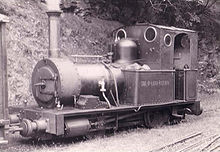
The author and biographerTom Roltvisited the line in 1949, along with the locomotive engineerDavid Curwen.[43]In the summer of 1950, Rolt wrote a letter to theBirmingham Postnewspaper suggesting that a rescue of the Talyllyn be undertaken. He received sufficient positive response for a meeting of interested enthusiasts to be held on 11 October 1950 at the Imperial Hotel in Birmingham. Around 70 people, includingPatrick Whitehouse,attended the meeting, with Rolt proposing the formation of a committee to look into the acquisition of the railway. With the support of the meeting, the committee – with Rolt as chairman and Whitehouse as Secretary – met for the first time on 23 October and immediately entered into negotiation with Haydn Jones' executors.[44]
The transfer of ownership to the committee was legally complex, but both parties agreed that all shares in the railway company would be transferred from Haydn Jones' estate to a new company called Talyllyn Holdings Ltd., whose board consisted of two directors from the executors and two from the committee. The transfer took place on 8 February 1951, at which point the newly formed Talyllyn Railway Preservation Society effectively took control of the railway. The Society immediately began to publicise its efforts, hoping to raise funds and find further volunteers to help reopen the railway, and by May nearly 650 members had joined the society.[45]The railway re-opened under the control of the Society for the first time on theWhit Mondaybank holiday, 14 May 1951,[46]with trains running between Wharf and Rhydyronen stations. Regular trains began to run on 4 June and continued through the summer,[47]with David Curwen acting as the first Chief Mechanical Engineer.[46]One of the volunteers who worked on the railway that month wasVic Mitchell.[48]

In the early years of preservation, the line struggled to operate using the original rolling stock. When the line was taken over in 1950Dolgochwas the only operating locomotive and it was apparent that it was in need of a major overhaul. To enable operations to continue, two further steam locomotives, Nos. 3 and 4, were purchased from the recently closed Corris Railway in 1951 and namedSir HaydnandEdward Thomasrespectively. Because both railways were built to the unusual gauge of2 ft 3 in(686 mm) it was relatively easy to adapt the Corris locomotives to work on the Talyllyn. No. 3 became the first new locomotive to travel on the railway for over 80 years in 1951, but it frequentlyderailed,and on inspection it turned out that the Talyllyn track was laid approximately half an inch (13 mm) wider than the official gauge, a deliberate policy by the old company to accommodate the longwheelbaseofTalyllyn.BothTalyllynandDolgochhad unusually wide wheel treads that allowed them to stay on the wide-of-gauge track. This problem was eventually cured by relaying the railway to its correct gauge and alteringTalyllyn's trailing wheels to allow them to swivel horizontally, shortening the locomotive's fixed wheelbase.[49]No. 4 was unserviceable when it arrived, but John Alcock,[50]the chairman of theHunslet Engine Company,was a member of the Preservation Society and had No. 4 overhauled free of charge at his works.[51]No. 4 then began service on the railway in 1952 and worked the majority of the trains that season.[52]

Another early addition to the locomotive fleet was No. 6Douglas,donated to the society by the Birmingham engineering firm Abelsons Ltd. This locomotive was built for thedepot railwayservingRAF Calshotwhere it worked until 1945, and, after rebuilding from its original2 ft(610 mm) gauge, it entered service in 1954.[53]Through the 1950s the volunteers and staff members of the TRPS rebuilt the line and rescued it from its state of decay, during a period characterised by a "Boy's Owncomicspirit of adventure, involving enthusiasm, ingenuity and a fair degree of irresponsibility ".[54]
On 22 May 1957 theBBCproduced a liveoutside broadcastfrom the railway, during whichWynford Vaughan ThomasandHuw Weldoncommentated on a trip from Dolgoch to Abergynolwyn. The publicity from this broadcast drew substantial numbers of visitors to the railway that summer, with more than 57,500 passengers carried, and this increase in revenue in turn enabled the railway to continue to improve its infrastructure and provide tourists with a better experience.[55]The following year locomotive No. 1Talyllynreturned to steam after an extensive overhaul.[56]
An important development during this period was the establishment of theNarrow Gauge Railway Museumat Tywyn Wharf station. The first exhibit for what was to become the museum was a locomotive donated in 1952 byGuinnessfrom their recently closedSt. James's Gate Breweryrailway.In 1954 the Preservation Society agreed to start work on a formal museum, and exhibits from around the United Kingdom were acquired to form the nucleus of the collection. In 1955 work started on converting the oldgunpowder storeat Wharf station into a temporary museum building, and in 1956 the first exhibit arrived at Tywyn.[57]
Securing the infrastructure: 1960–1969
[edit]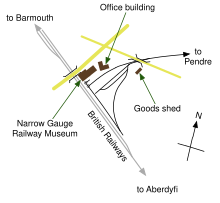
The 1960s proved to be a decade of consolidation for the Talyllyn. Pendre works underwent several much-needed expansions, adding additional covered storage for carriages and more workshop room. Modern machine tools, along with proper lighting and a new power supply were added. Substantial improvements to Tywyn Wharf station were also made, along with continued relaying and upgrading of the track to Abergynolwyn.[58]Passenger numbers continued to climb after the 1957 BBC broadcast; in 1960, 67,000 passenger journeys were made, increasing to 78,500 in 1964.[59]In response to this growing popularity the railway undertook a programme of new rolling stock construction.[60]
By the early 1960s Tywyn Wharf station was in need of major improvements. Before preservation, the station had contained only a fan of sidings, which meant that there was no way for the locomotive of an arriving train to run round the carriages. As a result, trains were pushed from behind as far as Pendre, where the locomotive could be moved past the carriages to the front of the train. Aloopwas installed at Wharf in 1952, being used from the start of the 1952 season, to avoid having to propel trains to Pendre,[61]but in the winter of 1964/65 a major upgrade of the station was carried out. This improved the track layout and extended the original office building to provide covered accommodation for passengers and a shop.[62]
As passenger numbers continued to grow during the late 1960s it became clear that further motive power was needed, especially as the rebuilt No. 1 was not performing well. The Talyllyn's unusual track gauge and restricted loading gauge meant that it was unlikely that a locomotive could be found that could work on the line unaltered,[63]so in 1969 a3 ft(914 mm) gauge steam locomotive was purchased from theBord na Mona(Irish Peat Board) with a view to rebuilding it for use on the Talyllyn. This locomotive was unofficially known asIrish Pete,a nod to its original use.[64]
Extension to Nant Gwernol: 1969–1980
[edit]
The preservation society had long held ambitions to extend the railway along the former mineral extension from Abergynolwyn to the foot of the Alltwyllt incline, and as early as 1959 work had begun to trace the owners of the land that the extension traversed. Planning began in the mid-1960s, but construction did not start until 1968 when the winding house for the Abergynolwyn village incline was demolished.[65]To bring the line up to passenger standards some of the curves needed to be eased, and this required blasting work, as the line runs on a narrow ledge on the hillside at this point.[66]The extension and new station at Nant Gwernol were opened on 22 May 1976 by Wynford Vaughan Thomas who drove in the ceremonial "golden spike"to complete the extension.[67]Despite this official opening ceremony, minor work still remained to bring the extension to the standard required to run regular passenger trains, but regular train services began on 29 May 1976.[68]
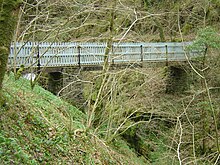
Although the extension of the railway was completed in 1976, work in the vicinity continued with the creation of footpaths connecting to the new station. A new footbridge was built crossing the Nant Gwernol gorge and connecting the station with the existing path on the east side of the river. The bridge and paths were opened on 3 May 1980 byLord Parry,the chairman of theWales Tourist Board.[69]By the mid-1970s, it had become clear that passenger numbers were no longer increasing. After 1973, the peak year for passengers on the Talyllyn with 186,000 passenger journeys made,[70]numbers were to decline consistently until the 1990s.[71]Preliminary work on the conversion ofIrish Petefor use on the Talyllyn, which had begun in the early 1970s, was put on hold in 1975 and the chassis and boiler were put into storage at Pendre.[72]
Consolidation: 1980–2001
[edit]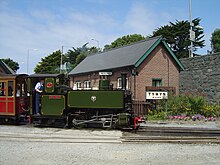
With passenger numbers falling and the line extended to Nant Gwernol, the railway entered a period of consolidation. By 1987, theboileron locomotive No. 6Douglaswas life expired and in need of replacement. Consideration was given to reviving the project to build a new locomotive from the components ofIrish Peteinstead of purchasing a new boiler forDouglasand in early 1988 work recommenced on the rebuilding of the ex-Bord na Mona locomotive. A new design for an 0-4-2 side tank locomotive was prepared by the railway's Chief Engineer John Bate, which reused the chassis and boiler from the locomotive with a new superstructure and the addition of trailing wheels, and the new locomotive, officially namedTom Roltafter the Preservation Society's first chairman, was put into service on 6 May 1991.[73]During this period further expansions of both Tywyn Wharf and Pendre stations were undertaken and Abergynolwyn station, which had been rebuilt as part of the Nant Gwernol extension in the 1970s, was expanded further to provide an additional attraction at the eastern end of the line.[71]
One major anomaly remained in the railway's operations: theRegulation of Railways Act 1889had required, amongst other measures, that all British passenger trains be fitted withcontinuous brakes.McConnel had secured an exemption for the Talyllyn Railway, on the basis that the low speed of operation meant they were unnecessary and that the cost of compliance would bankrupt the enterprise, but by the end of the 1990s theRailway Inspectoratewas insisting that the Talyllyn be brought into compliance with the act, a little over 100 years after it had passed. By 2001, the railway had fitted its entire passenger fleet with the necessary equipment, operated byair brake pumpsmounted on the locomotives.[71]
New museum: 2001–present
[edit]
The Preservation Society celebrated its 50th anniversary in 2001, and as part of the year of celebrations a major new project was launched to once more extend and improve facilities at Tywyn Wharf station. For many years the station had been home to semi-permanent buildings housing the Narrow Gauge Railway Museum, but the new plans for the station included the construction of a new two-storey building to house the museum and the extension of the existing station building to house a new cafe and booking office. Work began on the first phase of the project in January 2002.[71]In 2003 the railway received a £682,500Heritage Lotterygrant towards the £1,170,000 cost of redeveloping Wharf station,[74]and the new station and museum were officially opened byPrince Charles(later King Charles III) andCamilla,then Duchess of Cornwall, on 13 July 2005.[75]The railway has seen a steady increase in passengers carried since the turn of themillennium,with nearly 51,000 passenger bookings and 95,500 passenger journeys recorded in 2006,[76]although this figure is still only around half the peak figure carried in 1973. In 2011, the railway celebrated 60 years of preservation, and received anEngineering Heritage Awardfrom theInstitution of Mechanical Engineersin recognition of its importance in Welsh industrial heritage.[77]
The railway struggled financially for several years after the banking collapse of 2007, but slowly began to recover. In 2008 a large amount of equipment was purchased from the2 ft 6 in(762 mm) gauge military railway at RNAD Trecwn, including a large quantity of track components and three diesel locomotives. In 2011 the railway celebrated the 60th anniversary of its rescue by the volunteers of 1951.[78]
In April 2012 locomotive No.2Dolgochappeared at the Steel Steam and Stars Gala at theLlangollen Railway,running on a temporary section of narrow gauge track.[79]This was the first time thatDolgochhad operated away from its home railway in 146 years. In June 2013 the railway was awarded theQueen's Award for Voluntary Service.[80]2015 was the 150th anniversary of the official opening of the railway, and this was celebrated with a series of events throughout the year.[81]In 2021, the Slate Landscape of North-west Wales, which includes the Talyllyn Railway and Bryn Eglwys Quarry, was designated a World Heritage Site.[82][83]
(recorded 2009) |
(recorded 2009) |
Today
[edit]
The Talyllyn Railway remains a successful and popular tourist attraction. The original 1860s locomotives and passenger stock still run regularly alongside the roster of more modern rolling stock. The railway is promoted as one ofThe Great Little Trains of Wales,a joint marketing scheme launched in 1970 that encompasses ten narrow gauge railways in the country, mostly found in north and mid Wales.[84][85]
Special events
[edit]The railway operates a programme of special events throughout the year. These have include in the past the Anything-Goes Gala, Have-A-Go Gala, Tom Rolt Steam and Vintage Rally and Victorian Week. Occasional events are based on locomotives masquerading as their fictional counterparts from theSkarloey Railway.[86]Since 1984 there has been an annual running event calledRace the Train,which follows the railway track 7 miles (11 km) from Tywyn to Abergynolwyn and back again.[87]The challenge is for runners to complete the 14-mile (23 km) cross country route faster than the train, which takes around 1 hour 47 minutes.[88]
Young Members Group
[edit]The Young Members Group (YMG) are members and volunteers of the Talyllyn Railway Preservation Society who are between the ages of 14 and 25. On occasions during the peak season, the Railway has held Young Members Days in which the youngest qualified people available that day run the railway.[89]
Route
[edit] |
| Map of the Talyllyn Railway. |


Original passenger line
[edit]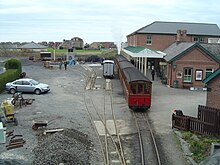
The main terminus of the line is atTywyn Wharf(originally known as King's Station, after a local landowner), where the railway's administrative headquarters and the Narrow Gauge Railway Museum are located. When the line carried traffic from the quarry, slates were transferred to theCambrian Railwayson thetranshipmentsidings. Leaving Wharf station, which stands at an elevation of 40 ft (12 m) above sea level, the line passes immediately under theA493MachynllethtoDolgellauroad and enters a longcuttingthat climbs towardsPendre,at a maximumgradientof 1 in 60. On the left (north) side of the cutting there was once a long siding used for gravityshuntingof wagons into the sidings at Wharf station. The railway runs through the cutting for about 0.5 miles (800 m), before passing under another road bridge and passing thelocomotive and carriage shedsand works at Pendre.[61]
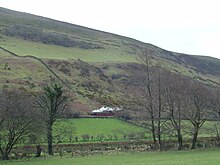
From Pendre, the railway passes over a gatedlevel crossingand runs beside an industrial estate before climbing up to Ty Mawr bridge and on to Hendy, the first of fiveminor halts,which serves the adjacent farm. The railway runs in an approximately north-easterly direction along theFathewvalley, mainly through fields of local farms on the valley floor, although this is where some of the steepest gradients on the line are to be found.[90]Theruling gradientof the line is 1 in 60.[91]
More local halts follow at Fach Goch, and Cynfal, the latter having a small platform.[90]The section from Cynfal toRhydyronenwas relaid in 1951 using rail purchased from the Corris Railway after the latter line's closure in 1948. Rhydyronen, arequest stop,was the first intermediate station built on the line, opening in 1867. A siding at the station was shortened in 1957 and removed completely circa 1975. A short steep climb under a road bridge follows the station, followed by a slight downhill gradient. Unlike the Ffestiniog Railway, the Talyllyn was not designed to be worked as a gravity line, however this is the only downhill section between Pendre and Nant Gwernol.[92]Another minor halt follows at Tynllwynhen, before the passing loop and request stop atBrynglas.[93]
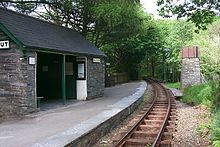
Above Brynglas, the line crosses the Cwm Pandy stream and enters a shallow cutting, climbing as it goes. The cutting ends at a road overbridge after which the line runs through open countryside as it starts to ascend the valley side on a ledge. After approximately 0.75 miles (1,210 m) it enters woodlands west ofDolgoch,climbing steadily, then curves to the south east and crosses the Dolgoch gorge on the Dolgoch viaduct, which carries the line 51 ft (16 m) above the Dolgoch ravine.[94]Dolgoch station is immediately east of the viaduct, situated on a left-hand curve at 187 ft (57 m) above sea level, and is the main intermediate station on the line, being popular with tourists visiting the nearbyfalls.The railway continues in a north easterly direction, curving through the woods and climbing the valley side. It shortly passes Quarry Siding, where a halt and passing loop are located; this is the site of a small oldshalequarry, the rock from which was used forballastingon the railway. A large permanent way and storage shed opened on the site in 2013.[95]The line continues its ascent towardsAbergynolwyn station,situated on a ledge cut into the hillside.[96]
Abergynolwyn to Nant Gwernol
[edit]
The original terminus of the statutory railway was Abergynolwyn, beyond which the railway continued as a 0.75-mile (1.21 km) long mineral extension, now converted for passenger use. The extension was originally sharply curved, as the line turns south east into the steeply sided Nant Gwernol gorge but these curves were eased when conversion for passenger use took place in 1976. The whole section is within woods, now owned by theNatural Resources Wales.Shortly after crossing over the forestry road the line reaches Tŷ Dŵr, where the original locomotive shed stood from 1865 until it was demolished after Pendre works opened in 1867. A slate water tower at this point was in use into the 1950s,[97]and was rebuilt in 2022.[98]
After passing the site of Ty Dwr the railway bends around 'Amen' corner and soon after the Village Incline is reached. From here the line runs into the gorge, high above the river on a narrow ledge, ending at the foot of the first incline leading to the Bryn Eglwys quarry. The original line fanned out into a set of three sidings, used to marshal trains of loaded slate wagons coming down from the quarry and empty wagons waiting to ascend.[99]Nant Gwernol station,the eastern terminus of the line, was built on the site of the sidings.[100][101]
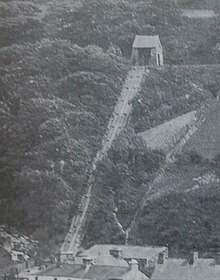
The village ofAbergynolwynwas built to house the quarrymen of Bryn Eglwys and their families, and to serve the village aninclinewith winding house was laid three quarters of the way along the mineral extension. The winding house for the incline stood on the narrow ledge, with the mineral line passing through it. The two-track incline dropped 150 ft (46 m) over a distance of 363 ft (111 m). At its foot, the line crossed the Nant Gwernol on a girder bridge. Immediately after the bridge, short lines branched off to the east from a wagonturntableto the coal yard and smithy of Pandy Farm and west to awriting slatefactory (later a carpenter's yard). The main branch then split to form a storage loop, with a further wagon turntable and a longer branch serving the houses and school to the north east. The main branch continued north, crossing the main road then passing between the two main terraces in the village before ending in a turntable and a final short line connecting to the Capel Jerusalem chapel.[102]The village incline was lifted during the early years of preservation, to provide much needed rail to replace the existing track.[103]The winding house was demolished in 1968 to allow realignment of the railway to form the extension to Nant Gwernol.[65]
Galltymoelfre Tramway
[edit]
Until the closure of the quarries in 1946, the line east from Abergynolwyn was worked as a mineral tramway – only slate and goods trains serving Bryn Eglwys ran on this section. The quarry lay about one mile (1.6 km) south-east of Nant Gwernol station and 300 ft (91 m) above it, with a further mineral tramway connecting the quarry with the railway.[104]What is now Nant Gwernol station was the terminus of the Talyllyn Railway proper. Here the line fanned out into a set of sidings where inbound trains were left and outbound slate trains assembled. The sidings were located on a narrow ledge in the side of the Nant Gwernol gorge.[101]
Rising south-east from the end of the sidings was the 633 ft (193 m) long, double track gravity operated,Alltwyllt incline,[105]from the top of which the Galltymoelfre Tramway ran south-east towards the quarry for about 0.5 miles (800 m). The tramway was laid in lightbridge railand worked for its entire existence using horses. The tramway ended at the foot of theCantrybedd incline,a 440 ft (130 m) long double track, gravity operated incline. This final incline rose to the north edge of Bryn Eglwys quarry, reaching a height of 612 ft (187 m) above sea level.[104]
Operation
[edit]The line has six steam locomotives for passenger trains and four diesel locomotives, which are primarily used for shunting and to haul works trains. It is unusual for all steam locomotives to be operable at the same time, as at least one is normally scheduled for overhaul.[106]The railway also owns 23 carriages and vans, including all of the original carriages and the brake van built for the railway.

The railway issingle track,so special measures have to be taken to prevent collisions. Before preservation, the railway operated a "one engine in steam"policy, but with growing passenger numbers it became necessary to install passing loops and a more stringent method of single line control was introduced.[107]The line is worked by Electric Keytokensinstalled in 1973, which authorise the driver to enter a section of single line, and these are interlocked to prevent more than one token being withdrawn for a section at any one time. There is a loop at Pendre, which was used from the opening of the railway for shunting purposes, and further loops were installed at Brynglas in 1953 and Quarry Siding in 1963.[108]When the Nant Gwernol extension opened in 1976, Abergynolwyn also became a passing loop.[109]
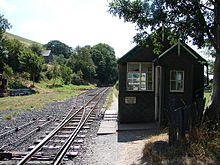
Each passing loop is controlled by a smallsignal box,known as a block-post. These house thelever framesthat control the points, the token equipment and telephones. The railway has few signals; instead it has stop boards at Pendre, Brynglas, Quarry Siding and Nant Gwernol, and theblockmanallows trains to proceed by use of flags.[110]There are colour light signals located at Tywyn Wharf, operated from the Control Office and disc signals controlled from the ground frame. Abergynolwyn has colour light signals, which are operated from the blockpost.[111]When the block-post is unmanned, it is the responsibility of the locomotive crew to change the token before proceeding.[112]
In popular culture
[edit]The Railway Series
[edit]The Talyllyn Railway is represented inThe Railway Seriesbooks by theReverend W. Awdryand its television adaptationThomas & Friendsas theSkarloey Railway;most of the fictional locomotives are based on real-life equivalents. Awdry visited the line on a family holiday in the early days of preservation and became involved as a volunteer soon afterwards. Several of the stories inThe Railway Seriescome from his real-life experiences at the Talyllyn, and some of the books contain full-page illustrations of Talyllyn locomotives.[113]One of Awdry's early experiences as a volunteer guard was waving for a train to depart Abergynolwyn too soon, causing the line's Refreshment Lady to miss the train; an event adapted in both the books and the TV series. His son Christopher and his wife Diana, and their son Richard would all volunteer with the Talyllyn as well. Wilbert's study along with his model trains were donated to the Talyllyn after his death and placed on display in the Narrow Gauge Railway Museum.[114]In 2021 the railway began hosting theAwdry Extravaganzasharing lectures onThe Railway Seriesfrom the Awdry study collection, and displaying artifacts and fan creations related toThe Railway SeriesandThomas & Friends.[115]The railway was briefly threatened legally by TV series creatorBritt Allcroftfor using the characters without paying her production company licensing fees, however since the railway's agreement to use the Skarloey Railway characters predated the TV series; the railway was able to continue using them without licensing them as part ofDay Out with Thomas.[116]
The Titfield Thunderbolt
[edit]The preservation of the Talyllyn Railway by volunteers was the inspiration for the 1953 filmThe Titfield Thunderbolt,[117]anEaling Studioscomedy about a group of villagers attempting to run a service on a disusedbranch lineafter closure.T. E. B. Clarke,the script writer for the film, had heard about the preservation of the Talyllyn and spent a day on the railway in 1951, and some of the early incidents in preservation were incorporated into the film. In the bookRailway AdventureTom Rolt recalled that he had hoped the film might be produced on the Talyllyn,[118]but it was eventually filmed on the recently closedCamertonbranch of theBristol and North Somerset Railwaybranch line along theCam Brook valleyinSomerset.[119]The actorHugh Griffith,who played Dan in the film, was a friend of Tom Rolt and an early vice-president of the preservation society.[120]
Railway with a Heart of Gold
[edit]In 1953, the American film producerCarson "Kit" Davidsonproduced a documentary film entitledRailway with a Heart of Gold,[c]portraying the early days of preservation. Some incidents were staged for the film, such as a piece falling off the locomotive, which Davidson later described as "corny".[121]However most of the film was simply a record of the work and incidents that took place on the railway at the time, including a dramatic shot ofSir Haydnderailing due to the poor condition of the track at the time.[121]The film, which was preserved by theAcademy Film Archivein 2012,[122]ends with the quote "It is a relic, this railway, a bit of ornamental scrollwork lifted from the pattern of yesterday and kept as a memento."[123]
See also
[edit]- British narrow gauge railways
- List of 2 ft 3 in gauge railways
- List of British heritage and private railways
- Tourism in Wales
Notes
[edit]- ^The spelling of local place names has changed during the history of the railway; for example Tywyn was generally spelled as "Towyn" until 1975.[2]Modern place name spellings are used throughout this article.
- ^According to theOrdnance Survey,the name of the lake is hyphenated. In the early days of the preservation society, it was decided that the name of the railway would be unhyphenated.[10]This convention has been applied to the railway ever since, and is used throughout this article.
- ^The film is available to view on theInternet ArchiveatRailway with a Heart of Gold.
References
[edit]- ^Boyd 1965, page 85
- ^Bate 2001, page 186
- ^abDrummond 2015, page 17
- ^Mitchell and Eyres, 2005 page 7
- ^Boyd 1988, page 44
- ^Rolt 1965, page 50
- ^Thomas 2002, page 32
- ^Ransom 1996, page 139
- ^Johnson 1999, page 27
- ^"No Names, No Hyphens, No Packdrill"(PDF).Talyllyn News.2.Talyllyn Railway: 1. November 1953.Archived(PDF)from the original on 17 February 2022.Retrieved16 April2020.
- ^Boyd 1965, page 61–62
- ^Zimmermann, Karl R. (22 June 2010).Little Trains to Faraway Places.Indiana University Press. p. 45.ISBN978-0253001498.Archivedfrom the original on 14 May 2021.Retrieved14 May2021.
- ^abcdRichards 1999, page 195
- ^Boyd 1965, pages 62–63
- ^Boyd 1988, page 9
- ^Drummond 2015, pages 9–11
- ^Boyd 1965, page 64
- ^Boyd 1988, page 45
- ^Potter, page 11
- ^Boyd 1965, page 65
- ^Boyd 1965, pages 68–69
- ^abBoyd 1965, page 70
- ^Rolt 1998, page 13
- ^Boyd 1965, pages 68–70
- ^abcBoyd 1965, page 71
- ^Boyd 1988, page 149
- ^Drummond 2015, page 97
- ^Drummond 2015, page 118
- ^Drummond 2015, page 97
- ^Rolt 1965, pages 82–83
- ^Rolt 1998, pages 5–6
- ^Boyd 1965, page 118
- ^"Death of Mr. William McConnell".The Cambrian News and Merionethshire Standard.John Askew Roberts, Edward Woodall & Richard Henry Venables. 17 October 1902.Archivedfrom the original on 9 August 2020.Retrieved10 February2020.
- ^Rolt 1998, pages 24–25
- ^abcBoyd 1965, pages 72–73
- ^Quine, Dan(March 2015). "The Talyllyn Railway in the late Haydn Jones era". Vol. 200. Heritage Railway.
- ^Ransom 1996, page 130
- ^Boyd 1965, pages 116–117
- ^Rolt 1998, page 21
- ^Boyd 1965, pages 73–74
- ^Quine, Dan."Not to be: The sad end of the Corris Railway". Vol. 220. Heritage Railway.
- ^Boyd 1965, page 74
- ^Potter, page 59
- ^Rolt 1965, pages 52–53
- ^Rolt 1965, pages 54–55
- ^abPotter, page 78
- ^Rolt 1965, page 56
- ^Johnston, Howard (June 2018). "617 publications so far...".The Railway Magazine.Horncastle: Mortons Media Ltd. pp. 33–37.ISSN0033-8923.
- ^Boyd 1988, page 260
- ^Rolt 1998, picture facing page 109
- ^Johnson 1997, page 57
- ^Rolt 1998, page 132
- ^Boyd 1965, pages 99–100
- ^Goddin 2002, page 46
- ^Rolt 1965, pages 61–62
- ^Mitchell and Eyres, 2005 page 25
- ^Rolt 1965, pages 112–114
- ^Bate 2001, chapter 5
- ^Rolt 1965, page 99
- ^Potter, page 208
- ^abBoyd 1965, page 77
- ^Mitchell and Eyres, 2005 page 19
- ^Mitchell and Eyres, 2005 page 87
- ^Bate 2001, page 155
- ^abThomas 2002, page 34
- ^Bate 2001, page 181
- ^Bate 2001, pages 184–185
- ^Bate 2001, page 189
- ^"Narrow Gauge News-Centre".Railway Times.18:11. June 1980.
- ^Bate 2001, page 169
- ^abcdThomas 2002, page 35
- ^Bate 2001, page 234
- ^Bate 2001, pages 234–237
- ^"Facelift for 'Thomas' station".BBC News.14 March 2003.Archivedfrom the original on 14 October 2007.Retrieved16 March2008.
- ^"Royal couple on track at station".BBC News.13 July 2005.Archivedfrom the original on 8 March 2006.Retrieved14 May2009.
- ^Robinson, John S (26 July 2007)."The annual TRPS Council Meeting report, 2006".Talyllyn Railway Company. Archived fromthe originalon 25 September 2011.Retrieved3 August2009.
- ^"Top engineering honour for railway that helped inspire Thomas the Tank Engine".Institution of Mechanical Engineers. 30 October 2011. Archived fromthe originalon 1 April 2012.Retrieved3 November2011.
- ^Drummond 2015, pages 58–59
- ^"No 2 Dolgoch at Steam Steel and Stars 3".Talyllyn Railway. 26 April 2012. Archived fromthe originalon 27 June 2015.Retrieved26 June2015.
- ^"Queen honours Talyllyn Railway".Heritage Railway Magazine. 2 June 2013. Archived fromthe originalon 21 January 2014.Retrieved21 January2014.
- ^Drummond 2015, page 60
- ^"Wales' slate landscape wins World Heritage status".BBC News. 28 July 2021.Archivedfrom the original on 10 August 2021.Retrieved28 July2021.
- ^"Bryneglwys Slate Quarry, Abergynolwyn Village and the Talyllyn Railway".Llechi Cymru.Archivedfrom the original on 28 July 2021.Retrieved28 July2021.
- ^Bate 2001, page 157
- ^Yarborough, Bruce."The Great Little Trains of Wales website".Great Little Trains of Wales.Archivedfrom the original on 14 May 2008.Retrieved6 April2008.
- ^"Peter Sam's 65th birthday".Talyllyn Railway. Archived fromthe originalon 19 August 2020.Retrieved17 August2020.
- ^"Race the Train website".Tywyn Rotary Club.Archivedfrom the original on 4 April 2008.Retrieved6 April2008.
- ^"Course - Rotary Challenge".Tywyn Rotary Club.Archivedfrom the original on 7 February 2022.Retrieved7 February2022.
- ^"Young Members".Talyllyn Railway Company. Archived fromthe originalon 23 August 2009.Retrieved3 August2009.
- ^abPotter, page 226
- ^"Talyllyn Railway history".Talyllyn Railway Company.Archivedfrom the original on 14 May 2010.Retrieved3 August2009.
- ^Potter, page 228
- ^Potter, page 229
- ^Boyd 1965, pages 82–83
- ^"The 'Guest House' opening at Quarry Siding".Talyllyn Railway. 13 May 2013. Archived fromthe originalon 19 August 2013.Retrieved2 February2014.
- ^Boyd 1965, pages 83–84
- ^Mitchell and Eyres 2005, page 70
- ^"Talyllyn Railway wins National Rail Heritage Award".Talyllyn Railway. 22 December 2022.Archivedfrom the original on 15 April 2023.Retrieved12 April2023.
- ^Boyd 1965, pages 84–86
- ^Holmes 2009, page 126
- ^abBoyd 1988, page 159
- ^Boyd 1988, page 153–162
- ^Potter, page 126
- ^abBoyd 1988, page 165
- ^Boyd 1988, page 162
- ^Willans, Karen (29 August 2007)."Talyllyn website – 100% availability".Talyllyn Railway Company. Archived fromthe originalon 21 December 2014.Retrieved6 September2014.
- ^Potter, pages 130–131
- ^Potter, pages 132–133
- ^"History Part 8: The Nant Gwernol extension".Talyllyn Railway.Archivedfrom the original on 1 January 2020.Retrieved15 June2019.
- ^Potter, page 222
- ^Bate 2001, pages 128 & 186
- ^Rolt 1965, page 102
- ^Potter, page 89
- ^"The Awdry Connection".Archivedfrom the original on 4 June 2022.Retrieved4 June2022.
- ^"An amazing Awdry Extravaganza weekend!".21 August 2021.Archivedfrom the original on 4 June 2022.Retrieved4 June2022.
- ^Herbert, Ian (19 April 2000)."True home of Thomas the Tank Engine to defy threats by 'Fat Controller'".Independent.Archivedfrom the original on 7 May 2018.Retrieved4 June2022.
- ^Huntley 1969, page 77
- ^Rolt 1998, page 115
- ^Castens, page 5
- ^Holmes 2009, page 40
- ^abFuller, volume 2, pages 96–98
- ^"Preserved Projects".Academy Film Archive.Archivedfrom the original on 8 August 2020.Retrieved28 April2020.
- ^Fuller, volume 2, page 330
Bibliography
[edit]- Bate, J. H. L. (2001).The Chronicles of Pendre Sidings.RailRomances.ISBN1-900622-05-X.
- Boyd, James I. C.(1965).Narrow Gauge Railways in Mid Wales.Oakwood Press.ISBN0-85361-024-X.
- Boyd, James I. C.(1988).The Tal-y-llyn Railway.Wild Swan Publications Ltd.ISBN0-906867-46-0.
- Castens, Simon (2001).On the Trail of The Titfield Thunderbolt.Thunderbolt Books.ISBN0-9538771-0-8.
- Cozens, Lewis(1948).The Tal-y-llyn Railway.Privately printed.
- Drummond, Ian (2015).Rails Along The Fathew.Holne Publishings.ISBN978-0-9563317-8-6.
- Fuller, Martin (2017).Talyllyn & Corris Steam Locomotives, Volume 2: Early Preservation and Locomotive Rebuilds.Sara Eade Publishing.ISBN978-0-9935828-3-7.
- Goddin, Geoff (September 2002)."Whose Heritage Railway is it? A Study of Volunteer Motivation"(PDF).Japan Railway & Transport Review.32:46–49. Archived fromthe original(PDF)on 26 March 2009.Retrieved1 May2009.
- Holmes, Alan (2009).Talyllyn Revived.The Talyllyn Railway.ISBN978-0-900317-07-1.
- Household, H. G. W. & Eldson, O. (June 1926). "The Tal-y-llyn Railway".Railway Magazine.Vol. 58. pp. 431–435.
- Huntley, John (1969).Railways in the Cinema.Ian Allan.
- Johnson, Peter(1997).The Heyday of the Welsh Narrow Gauge.Ian Allan.ISBN0-7110-2511-8.
- Johnson, Peter(1999).Welsh Narrow Gauge: a view from the past.Ian Allan.ISBN0-7110-2654-8.
- Johnson, Peter& Weaver, Rodney (1987).Great Preserved Locomotives: Talyllyn Railway No 1 Talyllyn & No 2 Dolgoch.Ian Allan.ISBN0-7110-1711-5.
- Mitchell, David J. & Eyres, Terry (2005).The Talyllyn Railway.Past and Present Publishing Ltd.ISBN1-85895-125-9.
- Potter, D. (1990).The Talyllyn Railway.David St John Thomas.ISBN0-946537-50-X.
- Ransom, P. J. G. (1996).Narrow Gauge Steam: Its origins and world-wide development.Oxford Publishing Co.ISBN0-86093-533-7.
- Richards, Alun John (1999).The Slate Regions of North and Mid Wales, and their Railways.Carreg Gwalch.ISBN0-86381-552-9.
- Rolt, L. T. C.(1998).Railway Adventure.Sutton Publishing.ISBN0-330-02783-2.
- Rolt, L. T. C.,ed. (1965).Talyllyn Century.David & Charles.
- Thomas, Cliff(2002).The Narrow Gauge in Britain and Ireland.Atlantic Publishing.ISBN1-902827-05-8.
- Waite, James (2023).Talyllyn Railway: A Journey By Steam.Narrow Gauge Album No. 2. Chippenham, Wilts, UK: Mainline & Maritime.ISBN9781900340663.Archivedfrom the original on 17 April 2023.Retrieved17 April2023.
- Woodcock, G. George (September 1938). "The Tal-y-llyn Railway".Railway Magazine.Vol. 83, no. 495. pp. 197–200.

